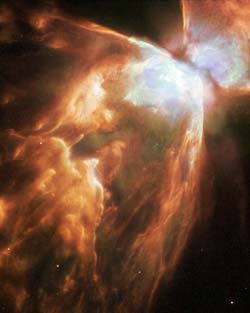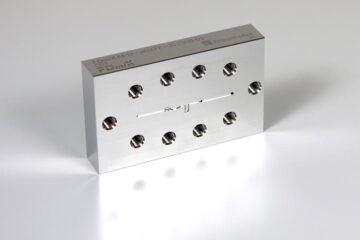Demise in ice and fire

The Bug Nebula, NGC 6302, is one of the brightest and most extreme planetary nebulae known. At its centre lies a superhot, dying star smothered in a blanket of icy ’hailstones’. A new Hubble image reveals fresh detail in the wings of this ’cosmic butterfly’. <br> <br>Credits: Credit: ESA/NASA and Albert Zijlstra
The Bug Nebula, NGC 6302, is one of the brightest and most extreme planetary nebulae known. At its centre lies a superhot dying star smothered in a blanket of ‘hailstones’. A new Hubble image reveals fresh detail in the wings of this ‘cosmic butterfly’.
This image of the Bug Nebula, taken with the NASA/ESA Hubble Space Telescope (HST), shows impressive walls of compressed gas. A torus (‘doughnut’) shaped mass of dust surrounds the inner nebula (seen at the upper right).
At the heart of the turmoil is one of the hottest stars known. Despite an extremely high temperature of at least 250 000 degrees Celsius, the star itself has never been seen, as it shines most brightly in the ultraviolet and is hidden by the blanket of dust, making it hard to observe.
Chemically, the composition of the Bug Nebula also makes it one of the more interesting objects known. Earlier observations with the European Space Agency’s Infrared Space Observatory (ISO) have shown that the dusty torus contains hydrocarbons, carbonates such as calcite, as well as water ice and iron. The presence of carbonates is interesting. In the Solar System, their presence is taken as evidence for liquid water in the past, because carbonates form when carbon dioxide dissolves in liquid water and forms sediments. But its detection in nebulae such as the Bug Nebula, where no liquid water has existed, shows that other formation processes cannot be excluded.
Albert Zijlstra from UMIST in Manchester, UK, who leads a team of astronomers probing the secrets of this extreme object, says: “What caught our interest in NGC 6302 was the mixture of minerals and crystalline ice – hailstones frozen onto small dust grains. Very few objects have such a mixed composition.”
The dense, dark dust torus around the central star contains the bulk of the measured dust mass and is something of a mystery to astronomers. They believe the nebula was expelled around 10 000 years ago, but do not understand how it formed or how long the dust torus can survive evaporation by the very hot central star.
Media Contact
More Information:
http://www.esa.int/esaCP/SEM2L477ESD_FeatureWeek_0.htmlAll latest news from the category: Physics and Astronomy
This area deals with the fundamental laws and building blocks of nature and how they interact, the properties and the behavior of matter, and research into space and time and their structures.
innovations-report provides in-depth reports and articles on subjects such as astrophysics, laser technologies, nuclear, quantum, particle and solid-state physics, nanotechnologies, planetary research and findings (Mars, Venus) and developments related to the Hubble Telescope.
Newest articles

For microscopic organisms, ocean currents act as ‘expressway’ to deeper depths
New research shows how tiny plant-like organisms hitch a ride on ocean currents to reach darker and deeper depths, where they impact carbon cycling and microbial dynamics in the subtropical…

FDmiX: Fast, robust series production of nanoparticles
Nucleic acid-based medications such as mRNA vaccines are opening up new therapeutic approaches. These active ingredients must be enclosed inside nanoparticles to ensure that they get to where they are…

Sensor measures oxygen content of breath
Oxygen saturation in the blood that is either too low or too high can cause physical harm or even death. This is why patients’ oxygen concentraions are monitored continuously in…





















